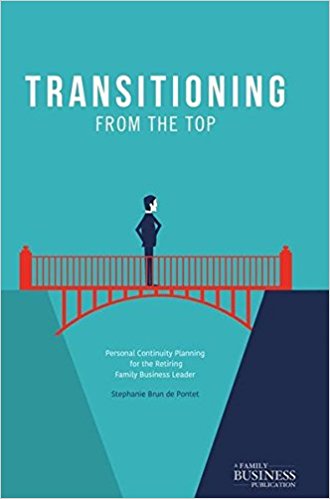Why would healthy, capable and driven people let go of a powerful role they enjoy if they have nothing to move toward afterward?
Change is hard. This particular change is really hard. Often retiring family business leaders lack clarity or options for a meaningful post-career role which is a major factor in succession struggles, resulting in wide-reaching negative consequences for the family and all stakeholders in the enterprise. The good news is retiring leaders can use their passions – including those discovered while running their family business to develop a personal path forward that benefits not only themselves, but also their family business and community.
In her book, Transitioning from the Top: Personal Continuity Planning for the Retiring Family Business Leader, family business consultant Stephanie Brun de Pontet takes an in-depth look at the dynamics and challenges for leaders in transition and the systems around them, to deliver insights on sources of difficulty and tips and tools for effective planning.
“My goal for this book is to share the compelling stories of retired CEOs’ journeys so that other driven individuals may start to imagine a post-business leadership future that inspires and excites them, even if they are a long way from retirement themselves,” explained Stephanie. “In addition to the real examples, the book offers numerous assessment tools to serve as conversation starters for the leader’s planning efforts.”
The book draws extensively on the experiences of more than a dozen former family business leader interviewees. These highly driven and accomplished business leaders share stories and lessons from their own personal continuity journey as they transitioned from the top of their companies. Combining these anecdotes with knowledge from years of consulting and research, Stephanie helps leaders broaden their sense of self as they look forward to a rich, purpose-filled next chapter in life.
Major ideas and themes covered include:
- How central your professional role is to your overall sense of identity
- How difficult (or easy) it may be for you to make significant changes
- The role of your physical and emotional health and resilience.
- The strength and nature of your key relationships (spouse, children, colleagues, and others)
- The stability and structures of the business (has it evolved adequately, for example, to support the transition?)
- The strength and relevance of your community networks
- How your cultural context might affect the transition
- How to translate your skills, passions, and experience into future opportunities
- The importance of concrete yet flexible planning
- Defining measures of success that you can track
- Understanding and overcoming common roadblocks
Reviews
“Transitioning from the Top is easy to read and relatable for anyone who is involved in their family’s business. The book represents a terrific resource for a CEO beginning to prepare for their departure from operational leadership – and perhaps as important – can truly help the generation coming up to better appreciate how and why this process is so challenging. In our experience, when stakeholders have shared understanding, transitions and evolutions run more smoothly.”
Nancy Goedecke, CEO & Chair, Mayer Electric
“Stephanie has not only done a great job of identifying an issue that a lot of former CEO’s struggle with as they look to find purpose and fulfillment in their life after they step away from their roles, but she also lays out some really practical guidance and suggestions on how to work through the transition. I believe that not only former CEO’s will find benefit from this book, but also many others who are in CEO or other key leadership roles in corporations as they prepare for a transition.”
Rod Brenneman, Former President and CEO, Seaboard Foods and Butterball, LLC
“Transitions in the family business are never easy. But there has been more focus in the last decades on effective family transitions. I believe families have made good progress in planning for family leadership transition. Stephanie Brun de Pontet’s book focuses on one area where there is still more opportunity for effective family transitions—helping the family leaders transition to “life after work”. The book gives great examples of family leaders transitioning out of the CEO and Chair positions into the next phase of life with meaning and purpose. For families planning for effective transitions in leadership, this is an area of focus that must be part of the process.”
Mary Andringa, Chair of the Board, Vermeer Corporation
“Personal Continuity is the most needed book in the field of family business. Brun de Pontet’s stories and insights show how senior generation leaders can find new identity, purpose, passion and fulfillment. Doing Personal Continuity Planning well also inspires more contribution to society and a strengthened family business for generations to come. The leaders interviewed who ‘let go’ can be understood as stewards for the benefit of others.”
John Ward, Clinical Professor of Family Enterprises at the Kellogg School of Management


